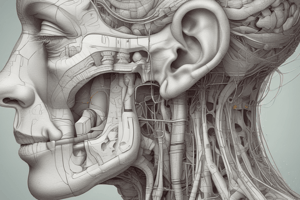Podcast
Questions and Answers
What is the main function of the cochlea in the ear?
What is the main function of the cochlea in the ear?
- Localizing the source of sounds
- Converting sound waves into electrical signals (correct)
- Maintaining balance and equilibrium
- Protecting the ear from external damage
What is the purpose of the Eustachian tube in the middle ear?
What is the purpose of the Eustachian tube in the middle ear?
- To connect the middle ear to the back of the throat (correct)
- To regulate the movement of the ossicles
- To amplify sound waves
- To convert sound waves into electrical signals
Which part of the ear is responsible for sound localization?
Which part of the ear is responsible for sound localization?
- Cochlea
- Outer ear (correct)
- Vestibule
- Semicircular canals
What is the most common cause of hearing loss?
What is the most common cause of hearing loss?
What is the term for a balance disorder caused by problems in the inner ear or brain?
What is the term for a balance disorder caused by problems in the inner ear or brain?
What is the term for an infection of the outer ear?
What is the term for an infection of the outer ear?
Flashcards are hidden until you start studying
Study Notes
Structure of the Ear
- The ear is divided into three main parts: outer ear, middle ear, and inner ear.
- The outer ear consists of:
- Pinna (visible part of the ear)
- Auditory canal (connects pinna to eardrum)
- The middle ear consists of:
- Eardrum (tympanic membrane)
- Ossicles (three small bones: malleus, incus, and stapes)
- Eustachian tube (connects middle ear to back of throat)
- The inner ear consists of:
- Cochlea (hearing organ)
- Vestibule (balance organ)
- Semicircular canals (balance organ)
Functions of the Ear
- Hearing: sound waves are converted into electrical signals that are transmitted to the brain.
- Balance: the inner ear helps to maintain balance and equilibrium.
- Sound localization: the ear helps to locate the source of sounds.
Mechanism of Hearing
- Sound waves enter the outer ear and travel through the auditory canal to the eardrum.
- The eardrum vibrates, causing the ossicles to vibrate.
- The vibrations are transmitted to the cochlea, where they are converted into electrical signals.
- The electrical signals are transmitted to the auditory nerve and then to the brain, where they are interpreted as sound.
Disorders of the Ear
- Hearing loss: can be caused by damage to the ear or auditory nerve.
- Ear infections: can occur in the middle ear (otitis media) or outer ear (otitis externa).
- Vertigo: a balance disorder caused by problems in the inner ear or brain.
Structure of the Ear
- The ear consists of three main parts: outer ear, middle ear, and inner ear.
Outer Ear
- Comprises of pinna (visible part of the ear) and auditory canal (connects pinna to eardrum).
Middle Ear
- Comprises of eardrum (tympanic membrane), ossicles (three small bones: malleus, incus, and stapes), and Eustachian tube (connects middle ear to back of throat).
Inner Ear
- Comprises of cochlea (hearing organ), vestibule (balance organ), and semicircular canals (balance organ).
Functions of the Ear
- Hearing: sound waves are converted into electrical signals transmitted to the brain.
- Balance: the inner ear helps maintain balance and equilibrium.
- Sound localization: the ear helps locate the source of sounds.
Mechanism of Hearing
- Sound waves enter the outer ear and travel through the auditory canal to the eardrum.
- Eardrum vibrates, causing the ossicles to vibrate.
- Vibrations are transmitted to the cochlea, where they are converted into electrical signals.
- Electrical signals are transmitted to the auditory nerve and then to the brain, where they are interpreted as sound.
Disorders of the Ear
- Hearing loss: can be caused by damage to the ear or auditory nerve.
- Ear infections: can occur in the middle ear (otitis media) or outer ear (otitis externa).
- Vertigo: a balance disorder caused by problems in the inner ear or brain.
Studying That Suits You
Use AI to generate personalized quizzes and flashcards to suit your learning preferences.




